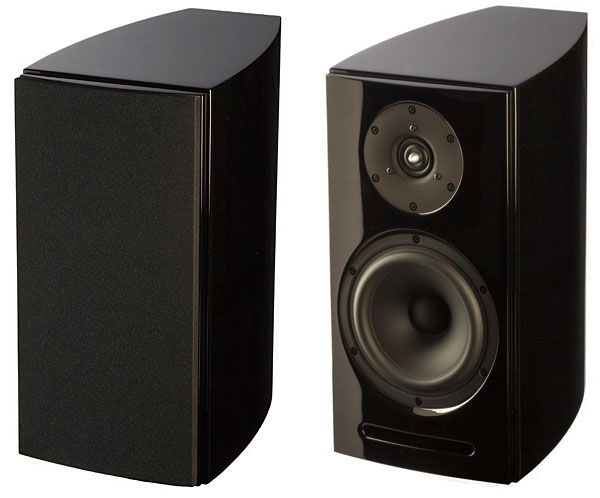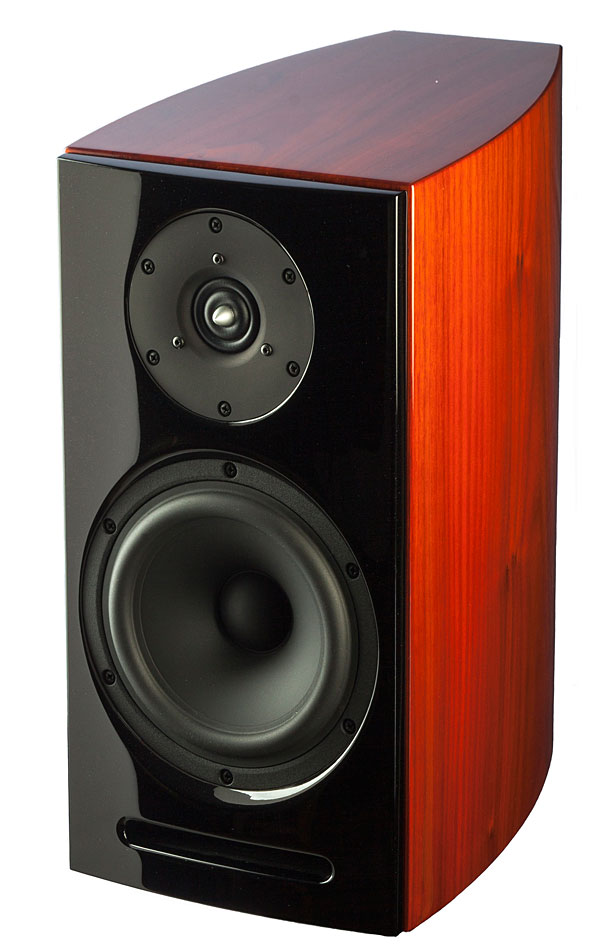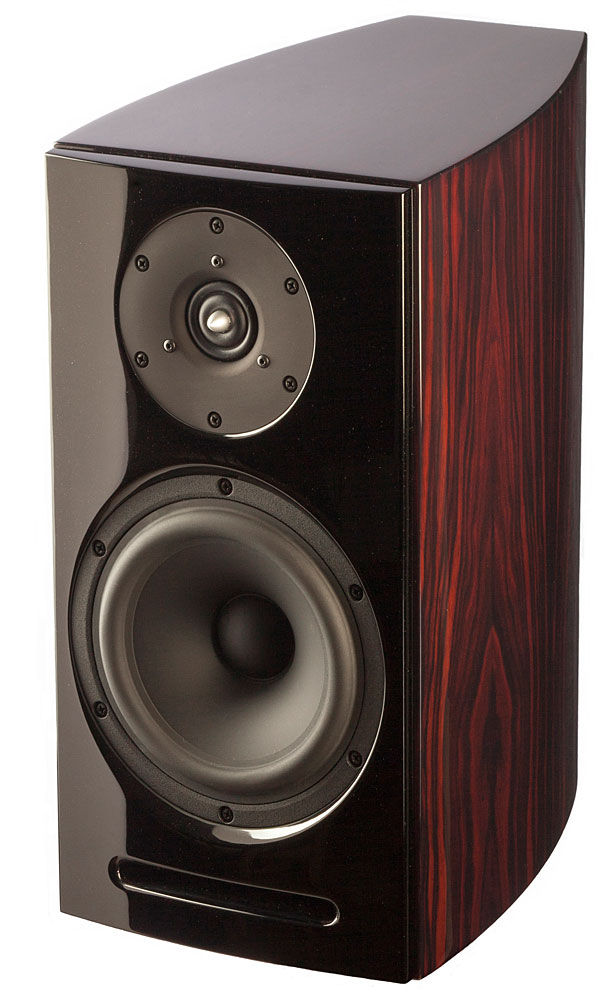| Columns Retired Columns & Blogs |
Wonder if that's fixable with a resistive port plug?
Cheers George

However, at the 2016 Consumer Electronics Show, Aerial Acoustics announced the 5T. While this, too, is a two-way stand-mounted design, gone was the sealed-box loading: the 5T's cabinet has a slot port at the base of the baffle. Gone, too, was the conventional rectangular box—the 5T's enclosure's graceful curves are formed by bonding together multiple layers of wood under high pressure for 48 hours. Also gone was the metal-dome tweeter, high frequencies now being reproduced by the 1" ring-radiator tweeter used in Aerial's three-way 7T tower, favorably reviewed by Kal Rubinson in March 2012. The woofer is now a 6.7" drive-unit custom-made for the 5T and featuring a papyrus-blend cone. And the price is now $3795/pair.
The 5T's drive-units are crossed over with what Aerial describes as "high-order multi-element" filters. The speaker's baffle is decoupled to some extent from the enclosure with damping glue, and slopes back at a gentle angle. The cabinet walls are cross-braced, and the interior is filled with long-fiber New Zealand wool that Aerial says was "specifically chosen for its sonic character." The review samples were finished in High Gloss Rosenut veneer, which looked stunning coupled with the gloss-black baffle. A Nero Metallic Black finish is available for the same price, but the premium High Gloss Ebony veneer adds $400 to the price of a pair. Like all Aerial Acoustics speakers, the 5T is engineered and assembled in America.
Listening
As I did with the Bowers & Wilkins 805 D3, which I also review in this issue, I used 24"-high Celestion stands with the Aerials, with small pads of Blu-Tack separating the speakers from the stands' top plates. (I left in place the small spikes that were fitted to each speaker; they cleared the top plate of the Celestion stand.) The center pillars of the stands were filled with a mix of sand and lead shot, and their bottom plates were spiked to the wooden floor beneath the carpet. The speakers were single-wired using the supplied jumpers, and toed-in to the listening seat, and I didn't use the grilles.

Aerial recommends placing the 5Ts between 2" and 24" from a wall, but I began with the speakers placed where the B&Ws had sounded best: well away from the room's boundaries. However, while the midbass was still acceptably high in level, the upper bass sounded too warm (see the "Measurements" sidebar). After some experimentation, I positioned the left speaker 36" from the closest sidewall and the right speaker 49" from its closest sidewall, both 75" from the wall behind them. While this placement sacrificed some low-frequency weight, it resulted in evenly balanced bass, and maximized the stability and accuracy of the stereo imaging—an area in which, I found, the Aerials excelled.
The dual-mono pink-noise track from Editor's Choice (CD, Stereophile STPH016-2) was reproduced with a stable, well-defined central image, but as I moved my head from side to side, I heard a bit of what the late J. Gordon Holt used to call "vertical venetian blinding"—a complicated interference pattern. If I sat up straight so that my ears were above the tweeter axis, the sound began to hollow out; but if I slouched in my chair, the pink noise started to sound a little midrange-prominent. To get the most neutral balance, the stands used with the 5Ts should place the listener's ears level with the tweeters.
Even then, however, the high frequencies were somewhat reticent, especially in comparison with the B&Ws, which I described as being "brilliant." David Gilmour's "unplugged" version of "Comfortably Numb" with Robert Wyatt, from Gilmour's In Concert: The Meltdown Concert from June 2001 (16-bit/44.1kHz ALAC file ripped from DVD-V, Capitol 92960 9), sounded a bit on the mellow side. The Aerial 5T had a similar balance to the KEF LS50, which I reviewed in December 2012, but played louder and deeper.
How much deeper? The low-frequency, 1/3-octave warble tones on Editor's Choice were reproduced at full level down to the 63Hz band, with the 50 and 40Hz warbles shelved down, but not quite as much they were with the KEFs. The 32Hz tone was just audible, those at 25 and 20Hz missing in action. However, despite my misgiving about the slot port, no wind noise was audible at 32Hz or below, though I could feel the air moving with my hand. The half-step–spaced tonebursts on Editor's Choice played evenly and with good control throughout the upper bass and midrange, and though I could hear some emphasis of the tones between 500 and 1000Hz with my ear close to the port, this was not noticeable at the listening position.
Piano is always good at revealing midrange problems, but when I played Daniel Barenboim's recent solo recording of Liszt's arrangement of "Solemn March to the Holy Grail," from Wagner's Parsifal, from Barenboim's On My New Piano (16/44.1 Tidal stream, Deutsche Grammophon 289 479 6724), I could hear nothing amiss. And the tolling in the left-hand register of Barenboim's unique straight-strung piano, developed in collaboration with instrument maker Chris Maene, sounded suitably majestic with the MBL Corona C15 monoblocks driving the Aerials. The bass guitar in "Black Magic Woman," from MoFi's "One-Step" reissue of Santana's Abraxas (2 45rpm LPs, Columbia/Mobile Fidelity Sound Lab MFSL-2-45013), spoke with authority in its lower register. This track segues into "Gypsy Queen"; when it did, Michael Shrieve's kick drum had the necessary impact.
I have no memory of downloading "#thatPower," by will.i.am and Justin Bieber (16/44.1 FLAC, from #willpower, Interscope), but there it was on the Aurender server. The kick drum and bass synth are mixed so high in this track that I had to get up from my chair and dance, but even as I did, I was impressed with the Aerials' superb bass control. This is a relatively small speaker, of course, and the maximum SPL I could achieve with "#thatPower" was 94dB(C), measured with Studio Six Digital's SPL iPhone app set to Fast. I was tempted to turn up the volume, as I'd done with the B&Ws.

My doing so, however, gave rise to trouble when I then played "Vultures," from the John Mayer Trio's Where the Light Is: John Mayer Live in Los Angeles (16/48 ALAC file ripped from DVD-V, Sony 8697-722727-9): At the level this old rocker like to play this track, Steve Jordan's kick drum in the opening drum pattern drove the 5Ts' woofers against their end stops. But up to that point, there had been no hint that the 5T was running out of bass headroom.
Of course, it's fair to say that the 5T is not intended for playing dance music at head-banging levels. What it does do is present near-holographic stereo images. In Vaughan Williams's Fantasia on a Theme by Thomas Tallis, from the Trondheim Soloists' Reflections (MQA-encoded 24/352.8 FLAC file, 2L 2L-125), the clarity with which the tune is handed off from one member of the solo quartet to another, each solidly and stably defined in the space between and behind the speakers, was close to being as good as I've heard in my room.
Since recording an arrangement for male voice choir of Eric Whitacre's Lux Aurumque in 2007, I have been collecting recordings of his choral works. A recent purchase as 24/96 Apple Lossless files from HDtracks is Water Night (Decca 001663602), an album of the composer conducting his own works. The performance for double choir by the Eric Whitacre Singers of When David Heard, the Hebrew king's lamentation on the death of his son Absalom, is definitive. From simple scale passages, Whitacre builds tone clusters that might be thought dissonant but are instead delicious. Aided by the clarity and solid stereo imaging of the 5Ts, I could readily hear how, at the first adagio, the staggered entries of the singers on the words my son under a held A-natural in the sopranos built a climactic atonal block chord expressing David's anguish. And when each singer subsequently re-enters across the stage, beginning with a solo tenor on the right, the vocal fragments paint the reverberant acoustic with the spatial equivalent of that block chord (footnote 1). This is how a pair of speakers with superbly accurate and stable stereo imaging can serve the music.
I ended my final listening session with the Aerial 5Ts with "Shipbuilding," from The Very Best of Elvis Costello (16/44.1 ALAC file ripped from CD, Universal Music). I first heard this song, written during the Falklands Conflict in 1982, performed by Robert Wyatt on a 12" single, but Costello's version has been in constant rotation here for 30 years now. With suck-and-blow compression on the piano, Chet Baker's solo trumpet treated with repeat echo, Costello's voice balanced preternaturally forward in the mix, and strings, organ, and drums all presented in different acoustics, there is nothing natural about the sound of this track. But through the Aerial 5Ts it sounded simply magnificent, Costello palpably hanging in space in front of me, the sound pulling me into the irony of the lyrics, which contrast the sinking of warships and the drowning deaths of sailors in the South Atlantic with the concomitant prosperity brought to shipyards back home. Magnificent.
Summing Up
The 5T lives up to Aerial Acoustics' reputation for producing fine-sounding, well-balanced loudspeakers. Though the price increase over its predecessor is a little alarming, the new speaker's fit and finish are superior to the original's more utilitarian appearance. When used within their dynamic envelope—these are not speakers for parties or dancing—the Aerial 5Ts will excel at painting stable, musically convincing sonic pictures between and behind them.

Wonder if that's fixable with a resistive port plug?
Cheers George

Excellent review -JA.
Happy Listening!

As a European I know I should tread carefully here, but is this a roundabout way of saying that all parts are actually manufactured in China? If so, why not just get over it and enjoy the 5T for what it is, judging by your review: a magnificent loudspeaker.
Cheers, Johan

I've owned these ever since this review came out. These are poorly balanced, nasal-sounding speakers with inadequate bass. If you read between the lines of the review and look at the measurements, you'll get the picture. They sure do look nice. But the Monitor Audio Silver 100 7Gs, which I bought several years later, are 1/3 the price, have just as much detail and tone, and a more balanced and full-bodied sound. Just get those. These were a big disappointment and waste of money.

At this price point I wasn't expecting JA to find speakers from this brand with off-axis windows this narrow, even if that B & W 803 D3 is $2K/pair more. What was Aerial thinking? Why opt for a ported box and/or other design choices just to get extended bass and/or more SPLs-THAT's what subwoofers are for! And I need two pairs of mains and a CC speaker for this long overdue 5.1 system build. So the hunt continues. Very frustrating.